September once again was the occasion for the Group's Annual General meeting. This year we took the opportunity to invite the winners of the David Miller Travel Bursary Award to receive their certificates and give short presentations on their work and how they spent or plan to spend their awards. The certificates were presented by Chris Moncrieff of VHB Herbs which sponsored the award along with SCI.
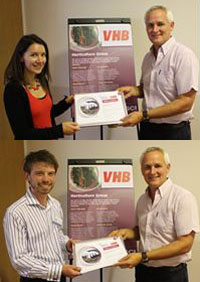
In July the International Society for Horticultural Science held a major Symposium of Horticulture in Europe (SHE 2012) in Angers, France. Prof Geoff Dixon represented SCI on both the Organising Committee and at the meeting. He summarises below the main outcomes of the meeting. As he points out in his report, some of the presentations are available online, but the full proceedings will in time be published in one of ISHS's usual Actae.
Editor
Horticulture in a Changing World
Prof Geoffrey R Dixon attended the Symposium of Horticulture in Europe, which took place in Angers, France from 1- 5 July, on the group's behalf and reports on his visit below:

The conference's oral presentations came either from plenary speakers or were selected by the Scientific Committee. Predominantly delegates presented their work as posters which by force of numbers required two sessions. All presentations were grouped into five topics. A general introduction and some keynote papers are reported below.
1. Innovative technologies
Much attention was focussed on the application of sensors for use in assessing quality and maturity, and there was also a good deal of interest in the remote assessment of anthocyanins and other health-related compounds. Within the marketing chain, barcoding and radio frequency identification (RFID) technology is becoming accepted practice.
Particular interest was shown in quality control for glasshouse and fruit crops, where resource conservation, especially energy, water and nutrients, were highlighted. Remote crop handling and automation demonstrated increasing demand for the reduction of labour across all horticultural crops.
Routes for the control of plant propagation and cropping include growth reactions to various parts of the light spectrum, and the manipulation of regulator metabolism. Integration with the use of beneficial microbes, climate control and the nutritional properties of growing media, all point towards total control of crops from seeding or asexual propagation, through to harvesting and onward passage to the consumer. This section was ably summarised by Prof Erik Pekkeriet from Wageningen University, the Netherlands, whose keynote address covered the introduction and application of robotics and automation into the glasshouse and intensive field crops sectors. This is now moving to three dimensional processing, combining rapid speed physical and chemical determination of crop characteristics during growth, and after harvest. This comes with intensive energy-saving systems. The overall aim is drive up quality and reliability, and to reduce costs and resources.
2. Consumer-driven sustainable supply chain management
One of the key messages from this Symposium is that horticultural R&D needs to focus clearly on the needs and demands of the retail consumer. Providing fruit, ornamentals and vegetables that match up to users' specifications is what the industry is all about, and science should be supplying the tools by which this can be accomplished. In this topic, identification of favourable traits, the elimination of defects and the provision of high quality fresh produce, formed the major research reports.
Tools for measuring quality, including fluorescence spectroscopy, X-ray micro-tomography and near infra-red, can assess both standing crops and harvested products. Evaluation of consumer demands shows clearly that quality is paramount in Europe, value-for-money is what retail purchasers want; and within that, they require assurances that production does not damage the environment. Sensitivity to environmental concerns is a key European characteristic. This compares with the USA, where price is more significant.
European consumers are environmentally-conscious and concerned. Analyses of supply chains were discussed largely by Prof Lena Eklund's comparison between Swedish and British supermarkets. The British retail market is seen as sophisticated and robust. Shoppers apparently exercise huge control over a shop's contents, although this may reflect the buyers' attitudes. British shoppers have moved markedly towards an interest in home-produced food, want to know the sources of produce, and even communicate directly with the grower. The technology which will permit this, is fast becoming a reality.
3. Sustainability and organic systems
Researchers placed heavy emphasis on opportunities and ways and means for the production of organic fresh produce. This may be a result of the way in which funding mechanisms are organised, since the market shows that consumers are interested in purchasing organic produce. Other quality criteria also apply, especially appearance, freedom from blemishes, and the presence of health-promoting compounds.
Considerable research efforts are being invested into biological control systems and the sources of nutrition which are deemed as 'natural' as opposed to 'synthetic'. This leads to some illogical situations, such as a preference for heavy metal sprays (eg copper) compared with minute quantities of materials that are perceived as 'synthetic', even though their chemical origins are vested in studies of natural processes (eg antibiosis).
There is substantial interest in managing diminishing resources, and in the context of fruit crops, this means conserving water supplies. Southern Europe in particular recognises that climate change will impose considerable constraints on the production of tree crops through the coming decades. Means for conserving water, including the development of new husbandry practices which limit evapo-transpiration, will be key to the survival of horticultural crops within the next decade.
Prof Xiloyannis Christos highlighted the importance of conserving winter rains, through improvements to soil fertility and biological activity.
Developing mechanisms for reduced and deficit irrigation, as developed by Prof Bill Davis at Lancaster University, are also fundamentally important contributions to this debate.
4. Horticulture and biodiversity
This theme provided an opportunity to discussion the contribution horticulture makes to the conservation of genetic resources. This is by maintaining gene banks of wild species, or keeping collections of primitive landraces, as well as developing open pollinated lines and some sophisticated F1 material. Horticulturists also provide the technology by which endangered plants may be propagated in protected conditions and living plant collections, and then possibly returned to their native habitats. Each of these points was covered in the oral and poster presentations.
Prof Pitrat provided an excellent review of Europe's systems for the conservation of genetic resources. Developing and maintaining these facilities is vital to ensure that genotypes which might contain traits of future importance are not lost. He showed how genebank conservation has provided breeding material for such novel crops as seedless grapes, watermelon and cucumber. He also highlighted the success of the European Common Catalogue, introduced in the 1960s, which now holds descriptions of 20,000 vegetable cultivars.
Also during the 1960s the French government offered Angers as the centre for Distinctness, Uniformity and Stability (DUS) testing for Europe. This has proved to be the foundation of successful horticultural research in the region.
5. Bridging between molecular processes and plant biology
It's now well recognised that detailed understanding of molecular level processes is a powerful tool, allowing the understanding of how traits are inherited, and how they may be manipulated to improve cultivars. This holds out the opportunity of breaking through the yield barriers, which constrict breeding based on Mendelian processes. It also allows the introduction of new traits from distantly-related or unrelated material.
At one time this was thought to be the sum total of what was needed; but now it is realised that agronomists and horticulturists must provide the husbandry technology essential to bring new lines into commercial use.
Prof Buck-Sorlin delivered a visionary keynote paper on this subject. He eloquently demonstrated the power of mathematical modelling in dissecting, analysing and explaining the interaction between genotype and environment which governs plant growth, reproduction and productivity.
The computer programs developed to handle data derived from genetic analysis can now be modified to add environmental dimensions. As a result new crop cultivars can be designed mathematically, and then tested before any biological breeding work is done. In reality, this simply replicates on a much grander scale what chemists and pharmacists have been about for decades. While modelling is very useful, he did end by reminding his audience that 'the plant is always right'!
6. Landscaping and urban horticulture
Throughout Europe there is much interest in the application of horticultural principles to landscape design and maintenance. This is especially true for urban areas, which are seen as in desperate need of green planting, in order to make them habitable. This whole area of study brings together horticulturists, sociologists, psychologists and medical researchers, since it is seen a very fruitful means of improving lifestyles, reducing physical and mental illness, and improving community cohesion.
Prof Christian Ulrichs from Berlin delivered a balanced analysis of urban horticulture. This valuable topic encourages non-horticulturists to become interested, involved and active in cultivating plants for pleasure in urban areas. It has substantial good effects for health, welfare and community cohesion.
But as he explained, the produce coming from these enterprises carries risks. It is likely that only a small proportion would be judged safe for consumption, as measured by the quality assurance criteria established for fresh produce on sale in supermarkets and other retail outlets. Analyses showed there are high concentrations of heavy metals and organic pollutants, as well as small dust particles, which are dangerous for asthma sufferers. While greening the urban environment is a priority, considering its produce as a significant contribution to food security is highly questionable.
Following the meeting, delegates visited the horticultural research, advisory and teaching facilities of Agrocampus Ouest, which are outside the city. Here a national top fruit collection, studies of vegetable pathogens, breeding cucurbits in co-operation with the commercial company Clause Seeds, and teaching facilities were displayed. The complex has an annual budget of €25 million and there are plans for substantial expansion. But both maintenance and capital spending are diminishing.
Acknowledgement: I am most grateful for the financial aid from the SCI Horticulture Group, which made my attendance possible. As there has been much confusion in Europe regarding the structure of our national societies, I hope that my visit dispelled some of the misunderstandings.
The UK could attract considerable opportunities for collaboration and funding by positioning itself at the forefront of European horticultural thinking. The quality and volume of German horticultural research was a noticeable contrast, and may well reflect its significantly increased funding for STEM (Science, Technology, Engineering and Mathematics) some five years ago.
Prof Geoffrey R Dixon
Plant of the Month
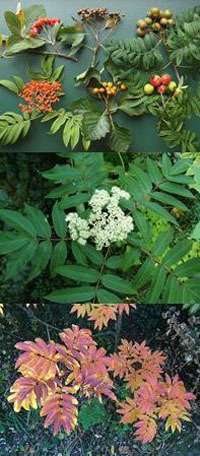
The genus Sorbus is made up of approximately 193 species from across the northern hemisphere (some pictured upper right). In the autumn many of these species provide a spectacular display of coloured fruit - from white, through pink to reds and oranges. Sargent's sorbus has good autumn colour to its leaves, as well as large clusters of small red fruit.
The species that make up the genus Sorbus have long been grouped into sub-genera but some taxonomists are suggesting raising these sub-genera to generic rank. The new genera would be: Sorbus (with leaves pinnate), Aria (leaves simple), Cormus (leaves pinnate), Chamaemespilus, and Torminalis (leaves simple and lobed). This tree sits firmly in the Sorbus sub-genus.
Sorbus sargentiana is a great tree for the smaller space, with all year round interest. In the winter it has large red sticky buds, which open to reveal pinnate leaves and white flowers (centre right) in the spring. The season of interest continues with good autumn colour (lower right) and attractive fruit. Unfortunately Sorbus flowers are typically foetid - smelling of trimethylamine.
The species hails originally from Sichuan and Yunnan provinces in China where it grows at altitudes of 2000 to 3000m. It is named after Charles Sprague Sargent, an American botanist who was the first director of the Arnold Arboretum (part of Harvard University).
The trees in the genus Sorbus have a multitude of economic uses, including using the fruits to ferment into alcoholic drinks. Some species are favoured by wood turners, and others have medicinal uses.
Alison Foster
Oxford Botanic Garden
Medicinal Plant of the Month
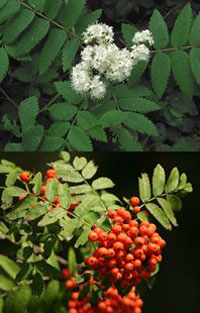
This species of Sorbus (picture upper right) is native to Europe and south western Asia. It has pinnate leaves like the Sargent's sorbus and clusters of red fruit in the autumn (lower right). The fruits have been used traditionally to treat diabetes, scurvy, kidney disorders, arthritis, diarrhoea, haemorrhoids and for blood purification.
The beneficial effects of these fruit are due to the presence of a compound called sorbitol. This substance accounts for 10% of the dry weight of the fruit (higher than other rosaceae fruit such as apples, pears, plums, cherries) and is a sugar type molecule. It is commonly used as a sugar substitute for diabetics. This is because Sorbitol is absorbed in the GI (Gastrointestinal) tract and converted to fructose in the liver. No glucose is released into the bloodstream. However, it is only half as sweet as sucrose.
Commercially, sorbitol (below) is produced synthetically by the reduction of glucose rather than being isolated from plant material. Sorbitol is widely used in pharmaceutical technology - as a moisture regulator, stabiliser, plasticiser and also in the food industry.
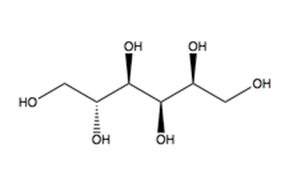
Alison Foster
Oxford Botanic Garden
News from our Associates

Fifteen UK companies will be forming joining the UK Pavilion at International Hortifair in Amsterdam from 30 October - 2 November. On Wednesday 31 October they will host an informal reception in the pavilion with the support of UK Trade and Investment. Visitors and international buyers will be able to see the latest offering from leading suppliers in a variety of different categories; from growing media, substrates and fertilisers, to production accessories, horticultural sundries, biological controls, glasshouse construction and engineering, right through to specialist vacuum cooling systems and patented watering control systems.

A French research group has published a study on the long term health effects of Roundup and Roundup-tolerant maize. This is the first peer reviewed lifetime feeding trial showing that both Roundup and Roundup-tolerant maize have long term health effects on animals. The UKPSF expected the publication to receive a lot of media attention and so it and the Society of Biology believe that they should be prompt in releasing a statement in response to the report. It is therefore seeking comments on the study. Any feedback that you are able to provide would be greatly appreciated. Let me know if you would be happy to be quoted, with your name attached to the statement. Please send comments to scihorticulture@btinternet.com
Horticulture Industry News
For the very latest horticultural news follow us on Facebook and or
Twitter.
UK Ministers reshuffle
In his recent reshuffle of government ministers, David Cameron made a number of changes at DEFRA, the Department for Environment, Food and Rural Affairs.
Owen Patterson becomes the Secretary of State for Environment, Food and Rural Affairs in place of Caroline Spelman while David Heath replaces Jim Paice as Minister of State for Agriculture and Food. Lord de Mauley, Parliamentary Under Secretary for Resource Management, the Local Environment and Environmental Science replaces Lord Taylor who has moved to the Home Office. The only DEFRA minister to escape unscathed was Richard Benyon MP, Parliamentary Under Secretary for Natural Environment, Water and Rural Affairs. Details of the new ministers can be found here.
Galapagos tomato key to whitefly resistance
Whitefly causes major damage to the tomato plant and its fruit, and is an important vector of plant virus dissemination. While the whitefly is suppressed through biological means in greenhouses, limiting the damage in open field cultivation requires human intervention in the form of weekly spraying with
Scientists at Wageningen in the Netherlands, together with a number of partners, have now discovered genes for resistance to the whitefly in a wild yellow-fruited relative of the common tomato (Solanum cheesmaniae). They hope that resistant varieties can be brought to market within two years, making chemical pest control unnecessary.
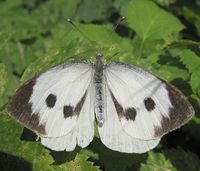
Plants release volatiles as a result of herbivore feeding that may affect the diversity and composition of plant-associated arthropod communities. However, the specificity and role of plant volatiles induced during the early phase of attack, ie egg deposition by herbivorous insects, remain poorly explored. Scientists compared the effect of egg-laying by the cabbage white butterfly (Pieris brassicae pictured right) and the cabbage moth (Mamestra brassicae). They found that female cabbage white butterflies were repelled by volatiles emitted by plants on which cabbage white eggs had already been laid but not when cabbage moth eggs had been laid. On the contrary two parasitic wasps (Trichogramma brassicae and Cotesia glomerata) were attracted by the same volatiles. The plant is thus encouraging these parasites to infest the eggs of the unwelcome butterfly while discouraging further egg-laying. More
New gene could lead to better bug-resistant plants
Research led by Michigan State University demonstrates that domestic tomatoes could re-learn a thing or two from their wild cousins. Long-term cultivation has led to tomato crops losing beneficial traits common to wild tomatoes and scientists have now identified a gene that is involved in one of these beneficial traits.
Wild tomatoes secrete from their Trichomes, or hair-like protrusions, a mixture of specialized chemicals that shape the interactions between the plant and its environment. One class of compounds, acyl sugars, is a frontline defender. Trichomes secrete acyl sugars to fend off pests. Little was known about how acyl sugars were produced until now, and this research identifies and describes the first gene that participates in the production of the protective sugars in cultivated tomatoes.
Acyl sugars play a critical role in allowing wild tomatoes to fend off bugs. Because cultivated tomatoes were not bred for their acyl sugar amounts and quality, they have reduced levels compared to wild ones. Understanding how they are made is the first step toward breeding cultivated tomatoes, and other plants in this family, to make them more resistant to herbivores.
Agrovista grows agronomy and technology base.
Agrovista, a leading agronomy specialist, crop protection and agricultural and horticultural product distributor, has just completed the purchase of Plantsystems Limited, the East Anglian based agricultural and horticultural consulting and technology business owned and managed by David Martin. Plantsystems provides consulting, agronomy and technology services to fruit, vegetable and specialist crop growers. The company is also the UK's leading weather data specialist and manages an extensive network of high-quality weather and soil moisture stations linked to a central server which provides live information and solutions for growers. The data is utilised for pest and disease modelling, irrigation management and control, crop assurance, crop protection risk mapping and environmental monitoring. Plantsystems manages and services a network of around 400 monitoring stations, either owned by the company or as part of a grower partnership.
Assessing a new technique for ensuring fresh produce remains Salmonella-free
Plasmas, a mix of highly energetic particles created when gases are excited by an energy source, can effectively inactivate microorganisms and as they don't involve extreme conditions such as high temperature they have been suggested for use in decontaminating food surfaces without affecting the structure. Researchers have now found Salmonella can be effectively inactivated by plasmas, but the length of exposure varied greatly depending on the type of produce.
Other variables, such as the ambient temperature of the produce or the growth phase of the Salmonella had no significant effect. To understand why, the researchers looked at the food surfaces with an electron microscope. At this microscopic level of detail, it was possible to see how Salmonella could 'hide' from the effects of the plasmas. Different structures, such as the bumps on the strawberries, the pores in lettuce leaves or the cell walls of potatoes create shadowed zones that block plasma reaching bacteria.
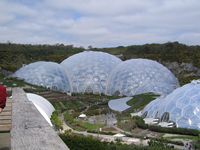
The Eden Project and Cornwall College, working in partnership, have submitted plans to Cornwall Council for a new centre at the Eden site near St Austell. The project, known as HOW2, is for a stunning new building that will provide facilities to showcase sustainable technologies and provide education, training and business engagement in their use and installation.
Gaynor Coley, Eden's Chief Executive, Enterprise, said: 'The exhibition space will allow visitors to experience and explore how we might live and work successfully in the 21st century and how each of us can take part. It will be rich with new ideas and ground-breaking technologies that could provide the answers to low-carbon living and visitors will be invited to participate and enter into an ongoing relationship with HOW2. It is estimated that 150 new jobs will be created by HOW2 over the next 10 years as it grows as a hub for people to share and skills'. More
Events Calendar
South West Growers Show
3 Oct, South West Growers
Exeter, UK
Precision Farming for Crop Protection
3 Oct, Association of Applied Biologists
Harper Adams, UK
Biopesticide Market Opportunities
5 Oct, University of Greenwich and Natural Resources Institute
Greenwich, UK
Integrated Fruit Production
7 - 12 Oct, International Organisation for Biological and Integrated Control of Noxious Animals and Plants
Kusadasi, Turkey
Acrylamide, furans and other food-borne contaminants
8 - 9 Oct, Association of Applied Biologists
Munich, Germany
Above Ground - Below Ground Interactions
8 - 10 Oct, British Ecological Society, Biochemical Society & Society for Experimental Biology
London, UK
BPOA Growers Look Ahead
11 Oct, British Protected Ornamentals Association
Stoneleigh, UK
Medicinal and Nutraceutical Plants
14 - 19 Oct, International Society for Horticultural Science
Aracaju, Brazil
Light in Horticultural Systems
15 - 18 Oct, International Society for Horticultural Science
Wageningen, The Netherland
Advances in Biological Control and IPM
16 - 19 Oct, Association of Applied Biologists
Marston, UK
Postharvest Quality of Ornamental Plants
16 - 19 Oct, International Society for Horticultural Science
Porto de Galinhas, Brazil
Vegetables and Greens
16 - 20 Oct, International Society for Horticultural Science
Yerevan, Armenia
National Fruit Show
17 - 18 Oct, Marden Fruit Show Society
Marden, UK
International Symposium on Persimmon
20 - 26 Oct, International Society for Horticultural Science
Guilin City, China
Annual Biocontrol Industry Meeting
22 - 24 Oct, International Biocontrol Manufacturers Association
Lucerne, Switzerland
Saffron Biology and Technology
22 - 24 Oct, International Biocontrol Manufacturers Association
Srinagar, India
BCPC Weed Review 2012
24 Oct, British Crop Protection Council
Peterborough, UK
Horti Fair
30 Oct - 2 Nov
Amsterdam, The Netherlands
CropWorld Global
6 - 8 Nov, British Crop Protection Council
London, UK
Brassica 2012
12 - 16 Nov, International Society for Horticultural Science
Catania, Italy
Soil & Water Live
13 Nov, Royal Agricultural Society of England
Stoneleigh, UK
Scientific Horticulture
13 - 14 Nov, Slovak University of Agriculture
Nitra, Slovakia
Interpoma
15 - 17 Nov, Fiera Bolzano
Bolzano, Italy
Biomolecular Thermodynamics
16 Nov - 17 Nov, Institute of Physics Biological Physics Group
London, UK
Citrus Congress
18 - 23 Nov, International Society for Horticultural Science
Valencia, Spain
Biostimulants
26 - 29 Nov, International Society for Horticultural Science
Strasbourg, France
Crop Protection in Southern Britain
27 Nov, Association of Applied Biologists
Peterborough, UK
Lychee, Longan and Other Sapindaceae Fruits
2 - 7 Dec, International Society for Horticultural Science
White River, South Africa
Integrating Canopy, Rootstock and Environmental Physiology in Orchard Systems
3 - 6 Dec, International Society for Horticultural Science
Stellenbosch, South Africa
Medicinal Plants and Natural Products
3 - 6 Dec, International Society for Horticultural Science
Quito, Ecuador
Crop Genomes and Crop Improvement
5 - 6 Dec, Association of Applied Biologists
Norwich, UK
Good Agricultural Practices (GAP) for Greenhouse Vegetable Production in the Mediterranean Region
9 - 12 Dec, International Society for Horticultural Science
Baqa', Jordan
International Crop Science Conference and Exhibition
6 - 9 Jan 2013, Pesticide Manufacturers Association of India
Nairobi, Kenya
If you would like to advertise a forthcoming event please contact charne.green@soci.org
Horticulture Group Contact Details
For submitting ideas or to volunteer to be part of a committee or a group, please contact:
Chairman - Peter Grimbly
Meetings Secretary - Alison Foster
Minutes Secretary - Margaret Waddy
Newsletter co-ordinator - Sue Grimbly scihortigroup@btinternet.com
Group Contact - Charne Green charne.green@soci.org T: +44 (0)20 7598 1594
